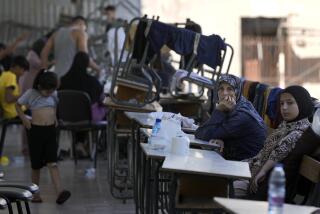Archeology Teams Scramble to Unearth Ancient Beirut Before Developers Begin Rebuilding on the Ruins of War
In the rubble of a modern-day Beirut smashed by 16 years of internecine warfare that ended in 1990, archeologists from around the world are scrambling to unearth the rubble of civilizations past.
With bulldozers nipping at their heels and developers rebuilding a modern, cosmopolitan city, these seekers of the ancient are discovering that Beirut was also a cosmopolitan city throughout most of its past.
Digging below the basements of battle-scarred buildings and mangled marketplaces while contractors wait impatiently to build new ones, the harried scientists found that the city has persisted through waves of occupation by Canaanites, Phoenicians, Greeks, Romans, English Crusaders and the Ottoman Turks.
The digs have already demonstrated that the city has been continuously occupied for at least 5,000 years, twice as long as had previously been proved, and has hosted more foreign invaders than had been suspected.
According to archeologist Leila Badre, director of the Museum of the American University of Beirut, there are 113 excavation sites in downtown Beirut, covering an area of more than half a million square yards.
The large-scale destruction of Beirut has provided a “once-in-a-lifetime opportunity” to explore the history of a still-occupied city, said archeologist Bill Duval of the University of Arizona. The excavations underway could not be attempted in a city with intact buildings and are “simply unprecedented,” he added.
With the developers looking over their shoulders, archeologists in Beirut have abandoned their traditional approach of digging for a few weeks or months, then stopping to examine their finds and interpret their meaning. Digging now proceeds year-round with as many workers as can be conscripted with the limited funds available.
“We’ve never dug continuously for so long,” Badre said. “We only stop when it rains.”
*
The teams have already warehoused millions of pottery shards, more than 10,000 coins, thousands of square yards of mosaics, tons of building materials and hundreds of pounds of animal bones. But even more may have been lost irretrievably in the construction of new buildings rising above the rubble.
The souk, or marketplace, where American University of Beirut archeologist Helga Seeden found 2,000 Roman lamps, 1,200 square yards of mosaics, seven silk industry basins, a set of well-preserved Byzantine shop porticoes and millions of potsherds was leveled by the bulldozers of the major development company Solidere to build a new souk.
Some walls of a fortress built by the Crusaders--and earmarked for preservation--were demolished, perhaps accidentally, by wrecking crews. Ten Iron Age tombs were crushed in construction of sewers. One Greek building was hastily disassembled and stored so a parking lot could be built.
Archeologists fear that many other sites will eventually be destroyed. “Our biggest question is: What will happen to all of this?” Badre said.
Badre has focused her efforts on a relatively small site next to the Mediterranean that proved to be the original location of the city. She described her work at a recent symposium at Loyola Marymount University.
The first people to live at the site, she found, were probably Canaanites, who settled next to the Mediterranean in the third millennium BC. Pottery shards found during digging inside the Crusader castle are typical of that period.
The Canaanites, who also populated the nearby cities of Byblos, Sidon and Tyre, eventually encircled their city with a stone wall reinforced by a clay embankment.
They named the city Birut, or “City of Wells.” The Greeks called the peoples of these cities Phoenicians. “But we don’t know what the residents of Birut called themselves because we have no written inscriptions,” Badre said.
Greek texts make no mention of Birut, however. “When we started excavating, we were not sure we would find a Phoenician city,” Badre said. “We knew we would find an earlier city, but we didn’t know who they were.”
Inside the wall, the early Birutans erected buildings of brick, joined by mortar, on stone foundations. Remains of jars from the buildings are similar to those found in other Phoenician cities.
Birut might just as well have been called the “City of Walls” because around the 18th century BC, the Canaanites enlarged the city by building a second wall a few meters outside the first. The workers used stones, some as much as 4 1/2 feet long, taken from a nearby hill.
*
“The stones were not cut, but were used as is,” and carefully fitted together, Badre said. The wall had an ornamental entrance and was reinforced by pilasters, square columns built at regular intervals along the wall.
“There is no evidence why they built the second wall or why they enlarged it by only a few meters,” she said. “The city was built on top of the wall and later razed. Nothing is left, so it is difficult to interpret why they enlarged it.”
Centuries later, they built a third wall, a more massive “glacis” with sloping banks constructed of large pebblestones. Material from the interior of this glacis dates from the 13th century BC, while that from the top dates from the 10th century. One type of pottery found inside the glacis was “totally unknown,” she said.
But whatever was built on top of this wall remains a mystery because the Ottomans flattened it for a road.
Badre’s site was recently declared a permanent archeological park, a decision that she views as a mixed blessing. While the site was still destined to become a road, her research was supported by Solidere. “As soon as it was designated an archeological park, however, they lost interest and stopped funding us,” she said.
No one knows where the road will go now.
More to Read
Sign up for Essential California
The most important California stories and recommendations in your inbox every morning.
You may occasionally receive promotional content from the Los Angeles Times.










